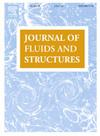溃坝水流作用下近海OWC电站的水动力特性:数值与试验研究
IF 3.5
2区 工程技术
Q1 ENGINEERING, MECHANICAL
引用次数: 0
摘要
采用数值与实验相结合的方法,研究了三维振荡水柱装置在溃坝水流作用下的水动力特性。分析了不同气室开度比和入射气流角度下的负载特性和流场分布。数值结果与45°入射角下的冲击载荷和水面高度的实验测量结果进行了验证,并扩展到6个额外的入射角:0°、15°、30°、60°、75°和90°。冲击载荷和气室压力峰值出现在90°角处,随入射角增大至0°而减小。在60°、45°和30°时,峰值水平合力分别下降了43.4%、55.3%和65.9%,而在0°时,峰值气压下降了68%。内墙和外墙的荷载大小相似,突出了在结构设计中考虑内墙力的重要性。流场分析表明,随着入射角的减小,射流腔内流动轮廓复杂,水流表面呈倾斜趋势。此外,增加气室的开度比可以显著降低峰值冲击载荷和空气压力,特别是在0%至3.5%的范围内。然而,较大的开口比可能会降低能量捕获效率。因此,选择一个合适的开口比,平衡负荷减少和能量捕获效率是OWC设计的关键。本文章由计算机程序翻译,如有差异,请以英文原文为准。
Hydrodynamic behavior of an offshore OWC power station under dam-break flows: Numerical and experimental study
The hydrodynamic behavior of a three-dimensional oscillating water column (OWC) device subjected to dam-break flow incidents was investigated using numerical and experimental methods. Load characteristics and flow field distributions were analyzed under various opening ratios of the air chamber and angles of incident flow. Numerical results were validated against experimental measurements of impact loads and water surface elevation at a 45° incident angle, and extended to six additional incident angles: 0°, 15°, 30°, 60°, 75°, and 90°. The peak impact load and air chamber pressure occurred at 90°, both decreasing as the incident angle varied to 0°. The peak horizontal resultant force decreased by 43.4 %, 55.3 %, and 65.9 % at 60°, 45°, and 30°, respectively, while peak air pressure decreased by up to 68 % at 0°. Loads on internal and external walls were of similar magnitudes, highlighting the importance of considering internal wall forces in structural design. Flow field analysis revealed complex flow contours and an inclined water surface inside the chamber, which became more pronounced as the incident angle decreased. Moreover, increasing the opening ratio of the air chamber significantly reduced peak impact loads and air pressure, especially in the range of 0 % to 3.5 %. However, larger opening ratios may reduce energy capture efficiency. Thus, selecting an appropriate opening ratio that balances load reduction with energy capture efficiency is crucial for OWC design.
求助全文
通过发布文献求助,成功后即可免费获取论文全文。
去求助
来源期刊

Journal of Fluids and Structures
工程技术-工程:机械
CiteScore
6.90
自引率
8.30%
发文量
173
审稿时长
65 days
期刊介绍:
The Journal of Fluids and Structures serves as a focal point and a forum for the exchange of ideas, for the many kinds of specialists and practitioners concerned with fluid–structure interactions and the dynamics of systems related thereto, in any field. One of its aims is to foster the cross–fertilization of ideas, methods and techniques in the various disciplines involved.
The journal publishes papers that present original and significant contributions on all aspects of the mechanical interactions between fluids and solids, regardless of scale.
 求助内容:
求助内容: 应助结果提醒方式:
应助结果提醒方式:


